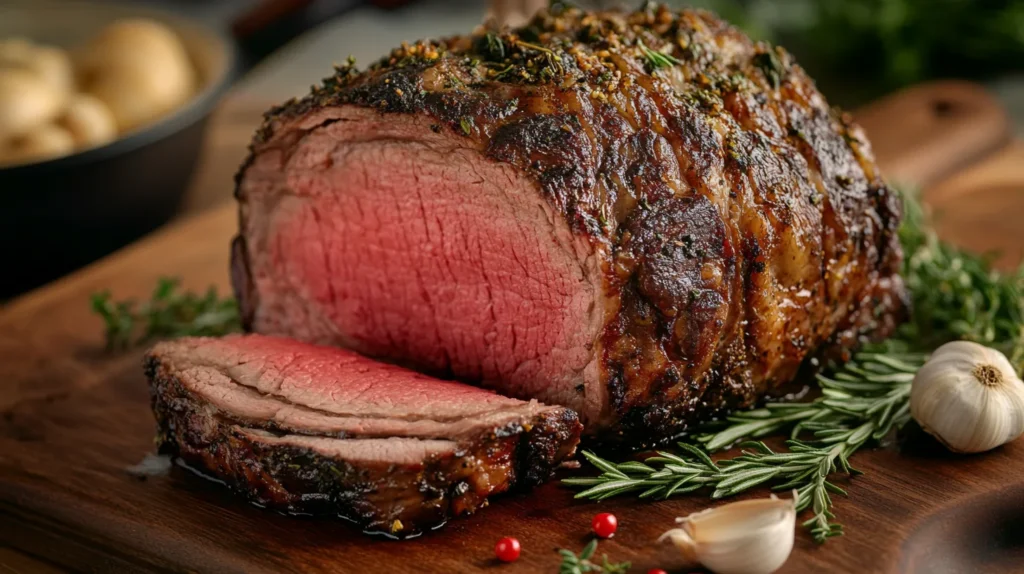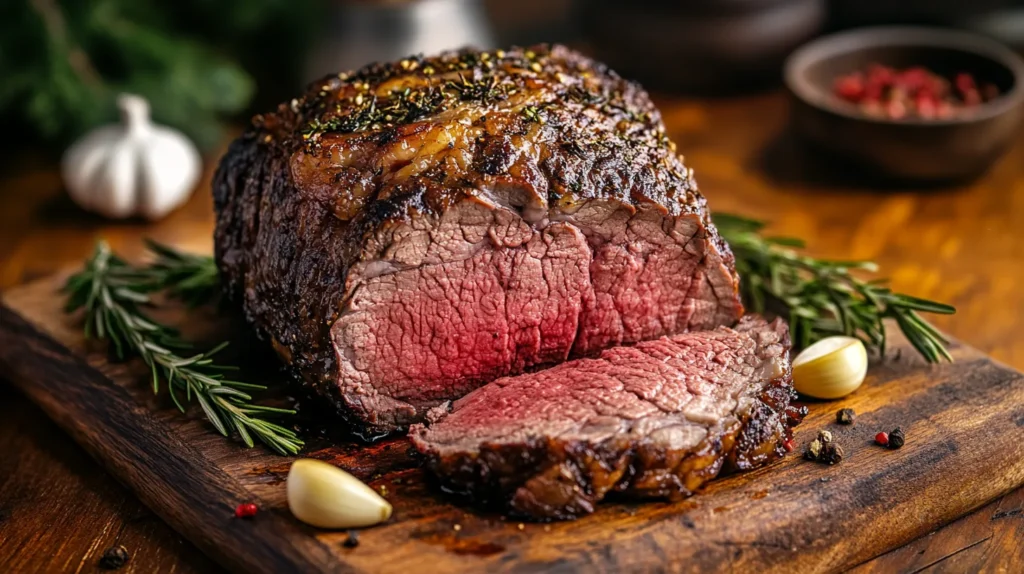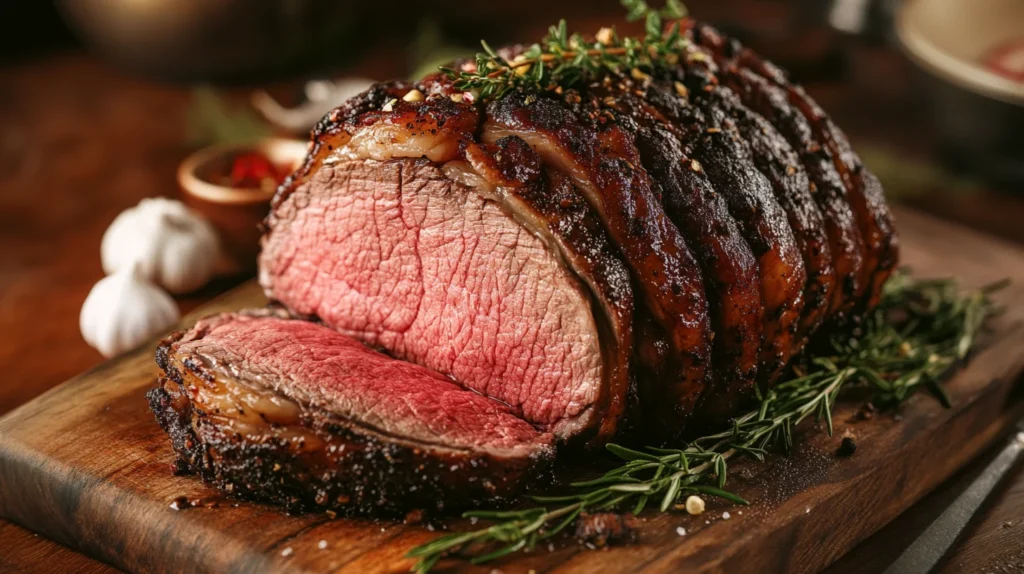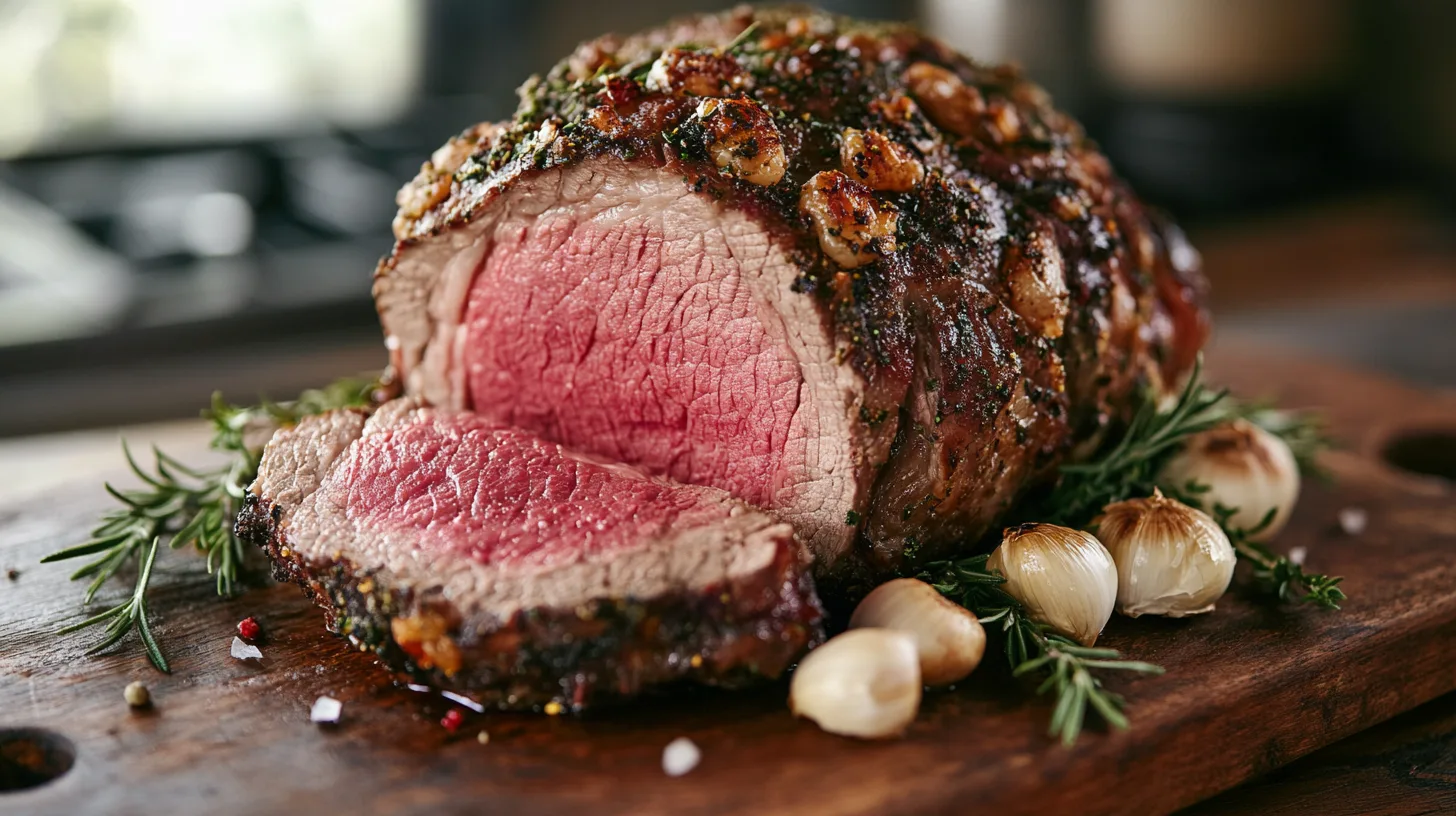The Ribeye Roast is not just a cut of meat; it’s a celebration of flavor, tenderness, and culinary art that can transform any gathering into a feast. Whether it’s a family holiday dinner or an intimate get-together with friends, mastering the Ribeye Roast can elevate your cooking skills and delight your guests. This guide will walk you through everything from selecting the perfect roast to cooking techniques that bring out its rich, savory goodness.
This guide will walk you through everything from selecting the perfect roast to cooking techniques that bring out its rich, savory goodness, perfectly complemented by a refreshing Sunrise Sunset Tropical Smoothie – a fruity blend to balance the meal.
Mastering the Ribeye Roast: From Selection to Savor
When it comes to cooking, understanding the nuances of ingredients is crucial. The Ribeye Roast, known for its rich marbling and robust flavor, deserves careful attention during both selection and preparation. A well-cooked ribeye can be tender and juicy, while a poorly prepared one may lead to disappointment. Let’s delve deeper into the essential steps to ensure your Ribeye Roast shines at the center of your dining table.
Selecting the Perfect Ribeye: Understanding Grades and Cuts
Choosing the right Ribeye Roast begins with understanding beef grading and cuts. The USDA grades beef based on its marbling—fat interspersed within the muscle—and its overall quality. The premier grades are Prime, Choice, and Select.
Prime grade beef offers the highest quality, featuring abundant marbling that translates to superior flavor and tenderness. However, this grade can be less accessible due to its higher price point. Choice grade, while slightly less marbled, still provides excellent taste and texture, making it a popular choice for many home cooks. Select grade is leaner and less flavorful, often best reserved for more budget-conscious meals.
When selecting your roast, pay close attention to the cut. The ribeye comes from the rib section of the cow and consists of several variations, including the boneless Ribeye and the bone-in Ribeye (often referred to as “Rib Steak”). The bone-in version tends to be juicier and has a richer flavor due to the added marrow.
Ultimately, your choice should reflect your personal preferences and budget. Aim for cuts that exhibit a good amount of marbling without being excessively fatty.
Assessing Marbling and Fat Content for Optimal Flavor and Tenderness
Marbling plays a pivotal role in determining the succulence and flavor profile of your Ribeye Roast. As the fat melts during cooking, it bastes the meat, infusing it with moisture and enhancing its richness. When assessing marbling, look for a consistent distribution of white flecks throughout the meat.
Fat content also influences cooking time and temperature. A well-marbled Ribeye Roast requires careful monitoring throughout the cooking process to prevent overcooking. Knowing how much fat is present can help you decide the best method for cooking and whether you need to adjust your seasoning approach.
Moreover, consider the thickness of the fat cap on the outside of the roast. While some fat can enhance flavor, excessive outer fat may need trimming to prevent greasiness and to ensure even cooking. A judicious balance of fat content will set the stage for a mouthwatering Ribeye experience.
Trimming Excess Fat: Techniques and Considerations
Once you’ve selected your Ribeye Roast, it may require some trimming to achieve the desired results. Here’s where personal preference comes into play. Some may appreciate a heartier fat cap for additional flavor, while others prefer a leaner cut.
To trim your roast, use a sharp knife and work slowly. Begin at one end of the roast and slice away excess fat while preserving the marbling within the meat. It’s essential to leave some fat intact, as this contributes to the final flavor.
Consider the cooking method you’ll be using to determine how much fat to trim. For instance, if you’re opting for slow roasting, leaving a bit more fat may enhance the flavor and moisture. Conversely, if you plan to grill, a leaner cut may prevent flare-ups. Always keep in mind that the goal is to achieve a balance that enhances the Ribeye’s natural flavors without overwhelming them.
Preparing Your Ribeye: Patting Dry and Seasoning Strategies
Preparation is key to achieving a superb Ribeye Roast. Start by patting the meat dry with paper towels. Drying the surface helps achieve a better sear and crust, which are critical components of a great roast. Once dry, it’s time to season.
When it comes to seasoning, simplicity often reigns supreme. A generous sprinkling of kosher salt and freshly cracked black pepper will accentuate the natural flavors of the Ribeye. For those wishing to explore further, consider adding garlic powder or fresh herbs like rosemary or thyme for an aromatic infusion.
Remember, seasoning isn’t just about what’s applied externally; it can also penetrate the meat. If time allows, consider salting the Ribeye a day in advance. This technique allows the salt to penetrate deeper into the meat, resulting in enhanced flavor and moisture retention during cooking.
With your Ribeye properly seasoned and prepped, you’re ready to dive into the various cooking methods that will unlock its full potential.

Cooking Methods for a Delicious Ribeye Roast
The cooking technique you choose can dramatically affect the outcome of your Ribeye Roast. Each method brings unique flavors and textures to the table, offering diverse ways to enjoy this beloved cut of meat.
Reverse Searing: A Detailed Guide to Achieving Perfect Results
Reverse searing is a relatively modern technique that has gained popularity among chefs and home cooks alike for its ability to create a perfectly cooked Ribeye with a stunning crispy crust. The method involves slow-cooking the roast at a low temperature before finishing it with a high-heat sear.
Start by preheating your oven to a low temperature, typically around 225°F to 250°F. Place your Ribeye Roast on a rack in a roasting pan to allow for even air circulation. Cooking at this lower temperature ensures that the meat cooks evenly and retains its juiciness.
Once the internal temperature reaches your desired doneness—usually around 10 to 15 degrees below your target—remove the roast from the oven. At this point, heat a cast-iron skillet or grill over high heat. Add a bit of oil and sear the roast for 1 to 2 minutes on each side until a golden-brown crust forms.
The beauty of reverse searing lies in its ability to produce consistent results without the risk of overcooking. Plus, the initial slow cook allows the flavors to develop more deeply, making every bite a true delight.
Oven Roasting: Temperature and Time Recommendations for Various Sizes
Oven roasting is the classic method for preparing a Ribeye Roast and offers simplicity along with incredible flavor.
Begin by preheating your oven to around 350°F. For a well-rounded roast, consider using a meat thermometer to monitor internal temperatures consistently. A general rule of thumb for cooking times is approximately 20 minutes per pound for medium-rare.
However, size does matter when it comes to cooking times. Larger roasts may require longer cooking periods, so using a thermometer becomes invaluable. Insert it into the thickest part of the meat to ensure accurate readings.
For enhanced flavor, consider creating a flavorful rub with herbs and spices to apply to the roast before placing it in the oven. Garlic, rosemary, and thyme pair beautifully with ribeye and can create a wonderful aroma as the roast cooks.
Lastly, allow the roast to rest after removing it from the oven. Resting enables the juices to redistribute throughout the meat, ensuring each slice is juicy and flavorful.
Sous Vide Cooking: Precision Temperature Control for Ultimate Tenderness
Sous vide cooking is a fantastic technique for achieving unparalleled tenderness in your Ribeye Roast. By vacuum-sealing the meat and immersing it in a water bath at a precisely controlled temperature, you can achieve perfect doneness without the risk of overcooking.
The first step is to season your Ribeye generously and seal it in a sous vide bag. Set your immersion circulator to your desired temperature—around 130°F is ideal for medium-rare.
Place the sealed roast in the water bath and let it cook for several hours, depending on the thickness of your meat. One of the perks of sous vide is that extended cooking times don’t result in mushy textures, allowing for flexibility in timing.
Once the sous vide cooking is complete, remove the roast from the bag and pat it dry. To finish off, sear the meat in a hot skillet or on a grill for a minute or two per side to develop a beautiful crust. The result is a Ribeye Roast that is incredibly tender, evenly cooked, and bursting with flavor.
Grilling: Direct vs Indirect Heat Methods for a Smoky Flavor
Grilling a Ribeye Roast imparts a delightful smoky flavor that can elevate your meal to new heights. There are two primary grilling methods to consider: direct heat and indirect heat.
Direct grilling involves cooking the meat directly over the flames, which can create a delicious char and enhance the crust. Preheat your grill to high heat, then place the seasoned Ribeye directly over the coals. Sear each side for a few minutes until a crust develops, then move the roast to a cooler part of the grill to cook through indirectly.
Indirect grilling is particularly useful for larger cuts, allowing for even cooking without burning the exterior. To do this, heat only half of the grill and place the Ribeye on the cooler side. Close the lid and monitor the internal temperature until it reaches your preferred doneness.
Regardless of the method you choose, make sure to let the roast rest afterward to lock in the juices. The smoky flavor combined with the tender meat will surely impress anyone at your table.

Flavor Enhancements and Accompaniments
No Ribeye Roast is complete without a thoughtful consideration of flavor enhancements and accompanying dishes. Elevating your roast can take it from good to extraordinary.
Herb and Spice Combinations: Elevating the Flavor Profile of Your Ribeye
Herbs and spices can cast a magical spell over your Ribeye Roast, bringing out its inherent flavors and adding complexity. Classic herb choices include rosemary, thyme, and oregano, which complement the beef’s natural richness beautifully.
Consider creating a compound butter by mixing softened butter with minced garlic, chopped herbs, and a pinch of salt. This mixture can be spread over the roast just before serving or melted over the slices for a decadent finish.
Experimenting with spices can also yield delicious results. Paprika, cumin, or even a hint of cayenne can add warmth and depth while balancing the meat’s richness. Don’t shy away from incorporating bold flavors, but remember to maintain harmony in the flavor profile.
Marinades and Brines: Adding Depth and Moisture
Marinating or brining your Ribeye Roast adds layers of flavor and moisture, leading to a more succulent final dish. Marinades consisting of acidic ingredients like vinegar, citrus juice, or wine help break down the protein, making the meat tender while infusing it with flavor.
A simple marinade might include olive oil, balsamic vinegar, garlic, and herbs. Allow the roast to soak in this mixture for a few hours—or even overnight—for maximum effect.
Brining is another effective method, especially for larger cuts. A basic brine solution of water, salt, and sugar can impart moisture and flavor. After a brining period, rinse the meat and pat it dry before cooking to avoid an overly salty taste.
Perfecting Your Roast’s Resting Period: Maintaining Juiciness and Tenderness
Resting is a critical step that should never be overlooked. After removing your Ribeye Roast from the heat source, give it ample time to rest—typically around 15 to 30 minutes. During this period, the juices redistribute throughout the meat, preventing them from running out and ensuring each slice remains juicy.
Cover the roast loosely with aluminum foil to retain heat while avoiding steam buildup, which can make the crust soggy.
Consider this resting phase an opportunity to prepare any sauces or sides that will accompany your roast. By the time you slice into it, your Ribeye will be perfectly tender and bursting with flavor, ready to impress your guests.
Complementary Side Dishes: Classic and Creative Pairings
Pairing your Ribeye Roast with complementary side dishes can elevate your meal to new heights. Traditional options like mashed potatoes or roasted vegetables offer a comforting familiarity, but don’t hesitate to get creative.
Consider serving your Ribeye with a vibrant chimichurri sauce—a fresh blend of parsley, garlic, red pepper flakes, and olive oil—that brings brightness and zest. Alternatively, a creamy blue cheese sauce can provide a rich contrast to the meat’s flavor.
For a lighter touch, try a refreshing arugula salad with shaved parmesan and lemon vinaigrette. This kind of salad balances the richness of the Ribeye while introducing freshness.
The beauty of Ribeye Roast lies in its versatility, allowing you to experiment with various flavors and textures while crafting a memorable dining experience.
Troubleshooting Common Ribeye Roast Challenges
While cooking a Ribeye Roast can be rewarding, it’s not without its challenges. Let’s address some common issues that can arise and how to overcome them.
Addressing Overcooked or Undercooked Roasts: Recovery Techniques and Tips
Overcooking is a common pitfall when it comes to Ribeye Roast. If you find yourself with an overcooked roast, don’t despair. Slice the meat thinly against the grain; this can help improve the eating experience. Additionally, consider drizzling the slices with a little beef broth or sauce to restore moisture.
On the other hand, undercooked roasts can be remedied by returning the meat to the heat source. If it’s a matter of just a few degrees, wrap the roast in foil and cook on low heat until it reaches the desired doneness.
Using a reliable meat thermometer can significantly reduce the chances of these mishaps. By monitoring the internal temperature closely, you can achieve that perfect level of doneness.
Dealing with Tough or Chewy Meat: Identifying Potential Causes and Solutions
If your Ribeye turns out tough or chewy, several factors could be at play. First, ensure you’ve chosen a high-quality cut of meat. Poor-quality beef or an improperly trimmed cut can lead to undesirable textures.
Another cause of toughness is cooking at too high a temperature. Low and slow is often the best approach for tougher cuts. If you happen to encounter a tough roast, consider slicing it thinly and serving it in a stir-fry or sandwich, allowing you to enjoy the flavors despite the texture.
Preventing Dryness: Maintaining Moisture Throughout the Cooking Process
Keeping your Ribeye Roast moist throughout the cooking process is essential for delivering an enjoyable dining experience. Using techniques such as basting with pan juices or marinades during cooking can help maintain moisture levels.
Additionally, avoid cutting into the roast before it has rested. Cutting too soon releases valuable juices and can lead to dryness. By allowing the meat to rest adequately, you’ll ensure that those juices remain locked inside, resulting in a tender and succulent roast.

Conclusion: Enjoying Your Perfectly Cooked Ribeye Roast
Mastering the Ribeye Roast is a journey filled with flavor exploration and culinary creativity. From selecting the perfect cut to experimenting with cooking methods and flavor enhancements, the world of Ribeye offers endless opportunities for delicious results.
As you embark on this delicious adventure, remember that practice makes perfect. Take the time to refine your techniques, learn from any challenges you face, and savor the sweet rewards of your efforts. Ultimately, your perfectly cooked Ribeye Roast will not only satisfy your taste buds but also create cherished memories around the dining table with family and friends. Enjoy the magic of cooking, and don’t forget to share in the joy that comes from a beautifully executed Ribeye Roast!
Try these recipes next!
If you’re looking for new dishes to complement your chocolate chip muffins, here are some delicious options:
- Savoring Spicy Beef and Broccoli – A Culinary Adventure for the Palate
- Edamame Egg Recipes Salad: A Nutritious Delight
- benignis potota soup recipe : Simple & Delicious
- Heart Cake – The Perfect Recipe to Celebrate Love and Sweet Moments

